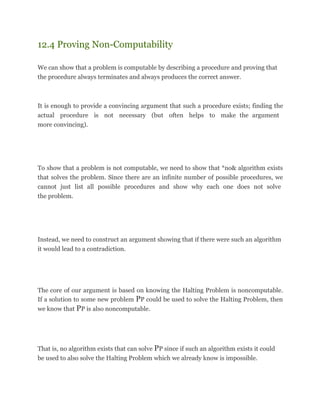proving non-computability
•Als PPT, PDF herunterladen•
0 gefällt mir•288 views
proving non-computability in introduction to computing
Melden
Teilen
Melden
Teilen

Empfohlen
Empfohlen
Weitere ähnliche Inhalte
Andere mochten auch
Andere mochten auch (17)
Understanding the Tremendous Value of Mobile Analytics

Understanding the Tremendous Value of Mobile Analytics
Tổ chức sự kiện khai trương,động thổ, khánh thành uy tín,chuyên nghiệp, chất ...

Tổ chức sự kiện khai trương,động thổ, khánh thành uy tín,chuyên nghiệp, chất ...
Improving Business Agility through IBM Business Insight Advanced

Improving Business Agility through IBM Business Insight Advanced
Ähnlich wie proving non-computability
Ähnlich wie proving non-computability (20)
Chapter 3 introduction to algorithms handouts (with notes)

Chapter 3 introduction to algorithms handouts (with notes)
Mehr von Rajendran
Mehr von Rajendran (20)
Kürzlich hochgeladen
Mehran University Newsletter is a Quarterly Publication from Public Relations OfficeMehran University Newsletter Vol-X, Issue-I, 2024

Mehran University Newsletter Vol-X, Issue-I, 2024Mehran University of Engineering & Technology, Jamshoro
This presentation was provided by William Mattingly of the Smithsonian Institution, during the third segment of the NISO training series "AI & Prompt Design." Session Three: Beginning Conversations, was held on April 18, 2024.Mattingly "AI & Prompt Design: The Basics of Prompt Design"

Mattingly "AI & Prompt Design: The Basics of Prompt Design"National Information Standards Organization (NISO)
Kürzlich hochgeladen (20)
Ecological Succession. ( ECOSYSTEM, B. Pharmacy, 1st Year, Sem-II, Environmen...

Ecological Succession. ( ECOSYSTEM, B. Pharmacy, 1st Year, Sem-II, Environmen...
Unit-IV; Professional Sales Representative (PSR).pptx

Unit-IV; Professional Sales Representative (PSR).pptx
Mattingly "AI & Prompt Design: The Basics of Prompt Design"

Mattingly "AI & Prompt Design: The Basics of Prompt Design"
This PowerPoint helps students to consider the concept of infinity.

This PowerPoint helps students to consider the concept of infinity.
SECOND SEMESTER TOPIC COVERAGE SY 2023-2024 Trends, Networks, and Critical Th...

SECOND SEMESTER TOPIC COVERAGE SY 2023-2024 Trends, Networks, and Critical Th...
Beyond the EU: DORA and NIS 2 Directive's Global Impact

Beyond the EU: DORA and NIS 2 Directive's Global Impact
proving non-computability
- 1. 12.4 Proving Non-Computability We can show that a problem is computable by describing a procedure and proving that the procedure always terminates and always produces the correct answer. It is enough to provide a convincing argument that such a procedure exists; finding the actual procedure is not necessary (but often helps to make the argument more convincing). To show that a problem is not computable, we need to show that *no& algorithm exists that solves the problem. Since there are an infinite number of possible procedures, we cannot just list all possible procedures and show why each one does not solve the problem. Instead, we need to construct an argument showing that if there were such an algorithm it would lead to a contradiction. The core of our argument is based on knowing the Halting Problem is noncomputable. If a solution to some new problem PP could be used to solve the Halting Problem, then we know that PP is also noncomputable. That is, no algorithm exists that can solve PP since if such an algorithm exists it could be used to also solve the Halting Problem which we already know is impossible.
- 2. Reduction Proofs. The proof technique where we show that a solution for some problem PP can be used to solve a different problem QQ is known as a reduction. A problem QQ is reducible to a problem PP if a solution to PP could be used to solveQQ. This means that problem QQ is no harder than problem PP, since a solution to problem QQ leads to a solution to problem PP. Example 12.1: Prints-Three Problem Consider the problem of determining if an application of a procedure would ever print 3: Prints-ThreePrints-Three Input: A string representing a Python program. Output: If evaluating the input program would print 3, output True; otherwise, output False. We show the Prints-Three Problem is noncomputable by showing that it is as hard as the Halting Problem, which we already know is noncomputable. Suppose we had an algorithm printsThree that solves the Prints-Three Problem. Then, we could define halts as: defhalts(p): return printsThree(p + '; print(3)')
- 3. The printsThree application would evaluate to True if evaluating the Python program specified by p would halt since that means the print(3) statement appended to p would be evaluated. On the other hand, if evaluating p would not halt, the added print statement never evaluated. As long as the program specified by p would never print 3, the application of printsThree should evaluate toFalse. Hence, if a printsThree algorithm exists, we would use it to implement an algorithm that solves the Halting Problem. The one wrinkle is that the specified input program might print 3 itself. We can avoid this problem by transforming the input program so it would never print 3itself, without otherwise altering its behavior. One way to do this would be to replace all occurrences of print (or any other built-in procedure that prints) in the string with a new procedure, dontprint that behaves like print but doesn't actually print out anything. Suppose the replacePrints procedure use printsThree to define halts: is defined to do this. Then, we could def halts(p): return printsThree(replacePrints(p) + '; print(3)')